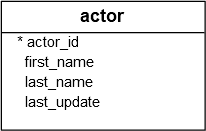PL/pgSQL Row Types
Summary: in this tutorial, you will learn how to use the PL/pgSQL row types to declare row variables that hold a complete row of a result set.
Introduction to PL/pgSQL row types
Row variables or row-type variables are variables of composite types that can store the entire rows of a result set.
These row variables can hold the entire row returned by the select into or for statement.
Here’s the syntax for declaring a row variable:
row_variable table_name%ROWTYPE;
row_variable view_name%ROWTYPE;In this syntax:
- First, specify the variable name.
- Second, provide the name of a table or view followed by
%andROWTYPE.
To access the individual field of a row variable, you use the dot notation (.) as follows:
row_variable.field_namePL/pgSQL row-type variable example
We’ll use the actor table from the sample database to show how row types work:
 The following example retrieve the row with id 1 from the actor table and assign it to a row variable:
The following example retrieve the row with id 1 from the actor table and assign it to a row variable:
do
$$
declare
selected_actor actor%rowtype;
begin
-- select actor with id 10
select *
from actor
into selected_actor
where actor_id = 10;
-- show the number of actor
raise notice 'The actor name is % %',
selected_actor.first_name,
selected_actor.last_name;
end;
$$;How it works.
- First, declare a row variable called
selected_actorwith the same type as the row in theactortable. - Second, assign the row whose value in the
actor_idcolumn is 10 to theselected_actorvariable using theselect intostatement. - Third, show the first and last names of the selected actor using the
raise noticestatement.
Summary
- Use row type variables (
%ROWTYPE) to hold a row of a result set returned by theselect intostatement.